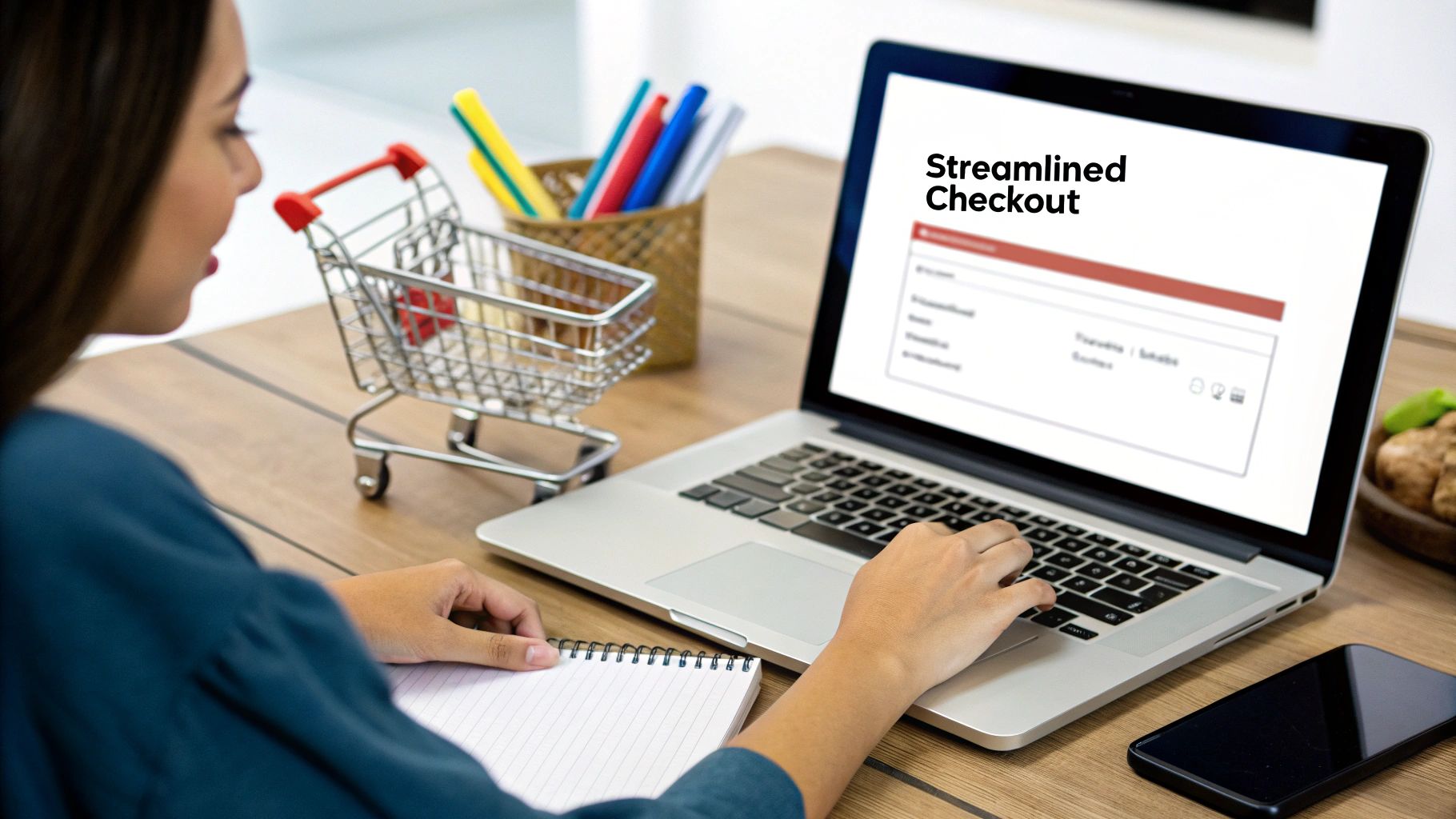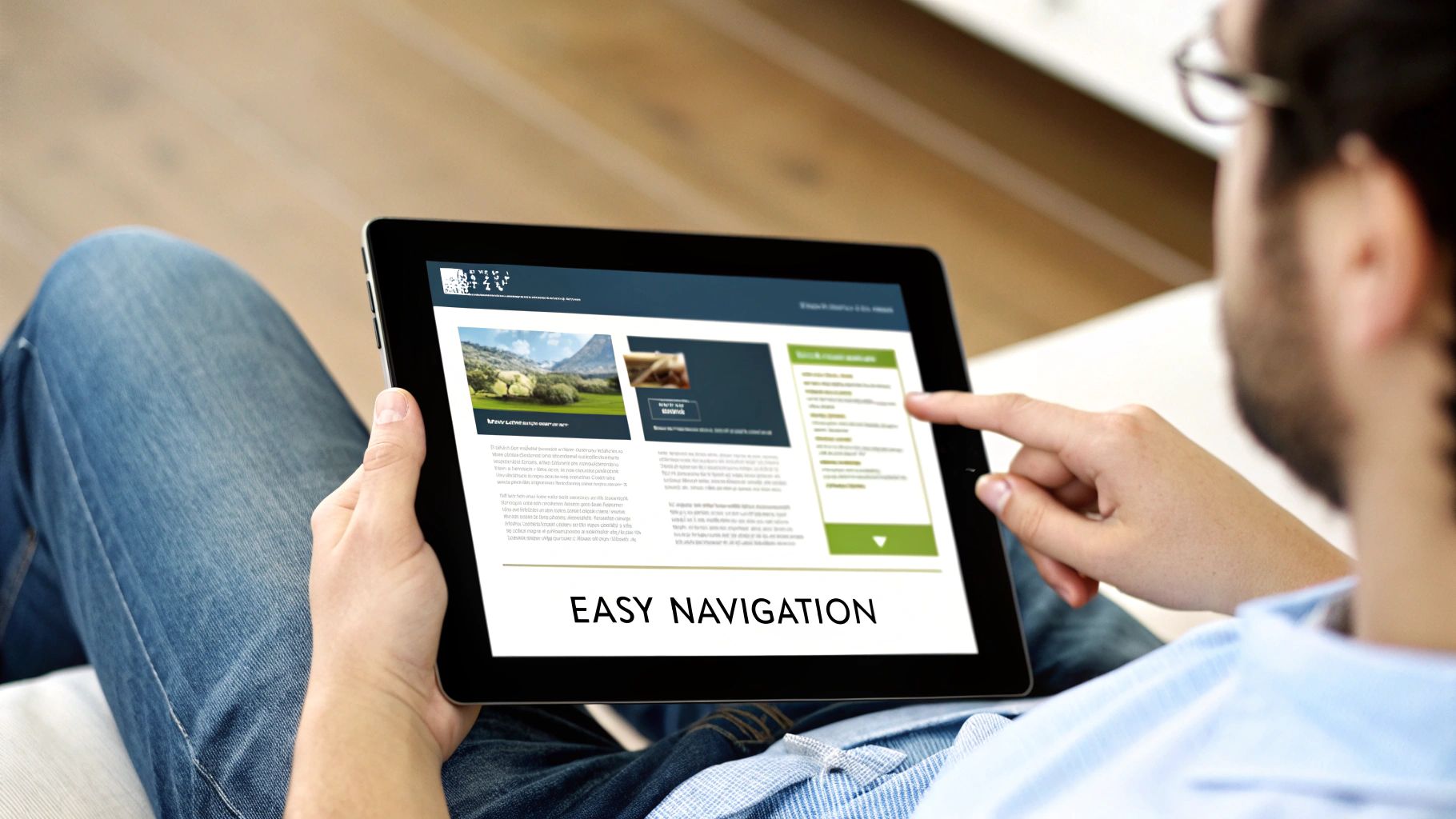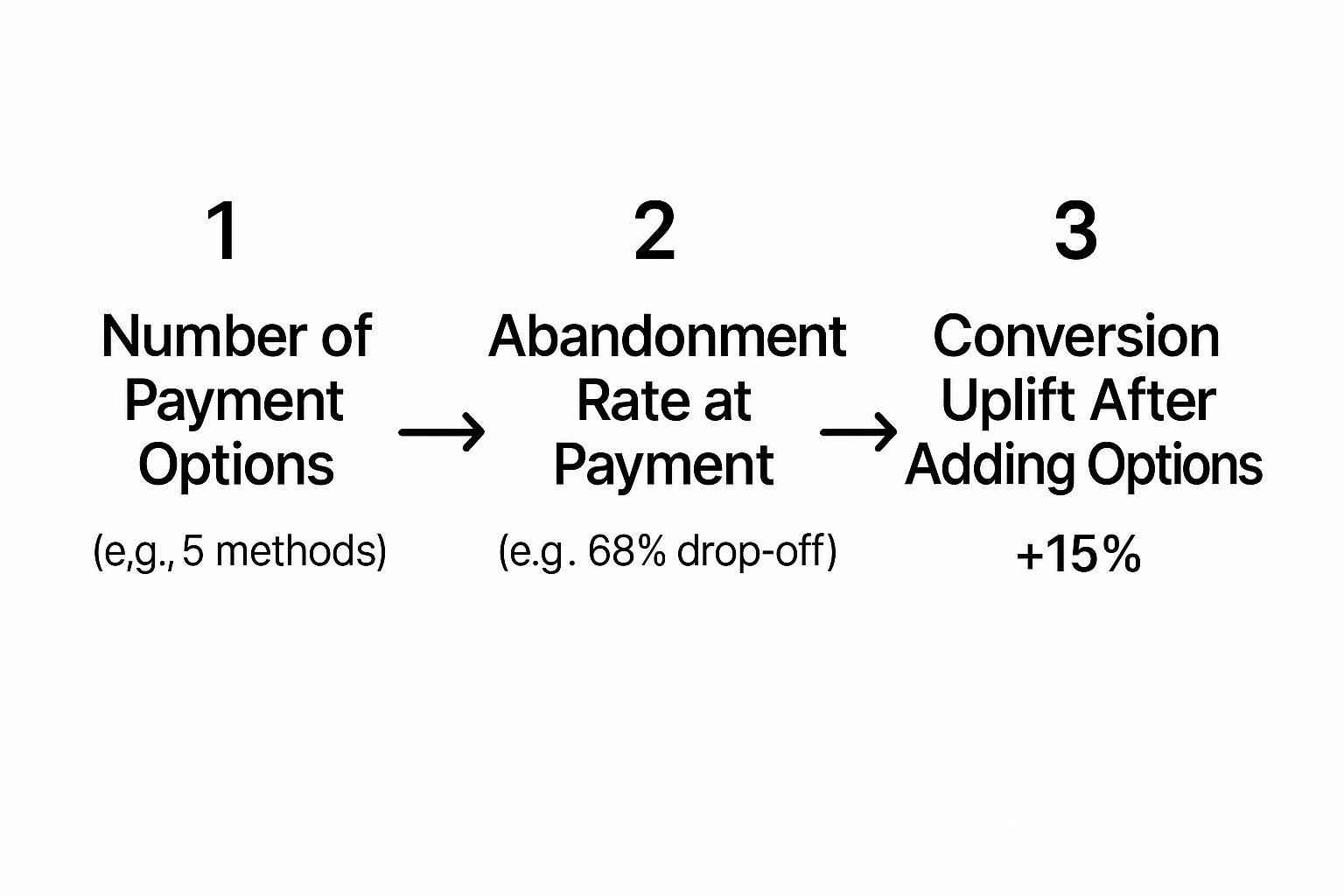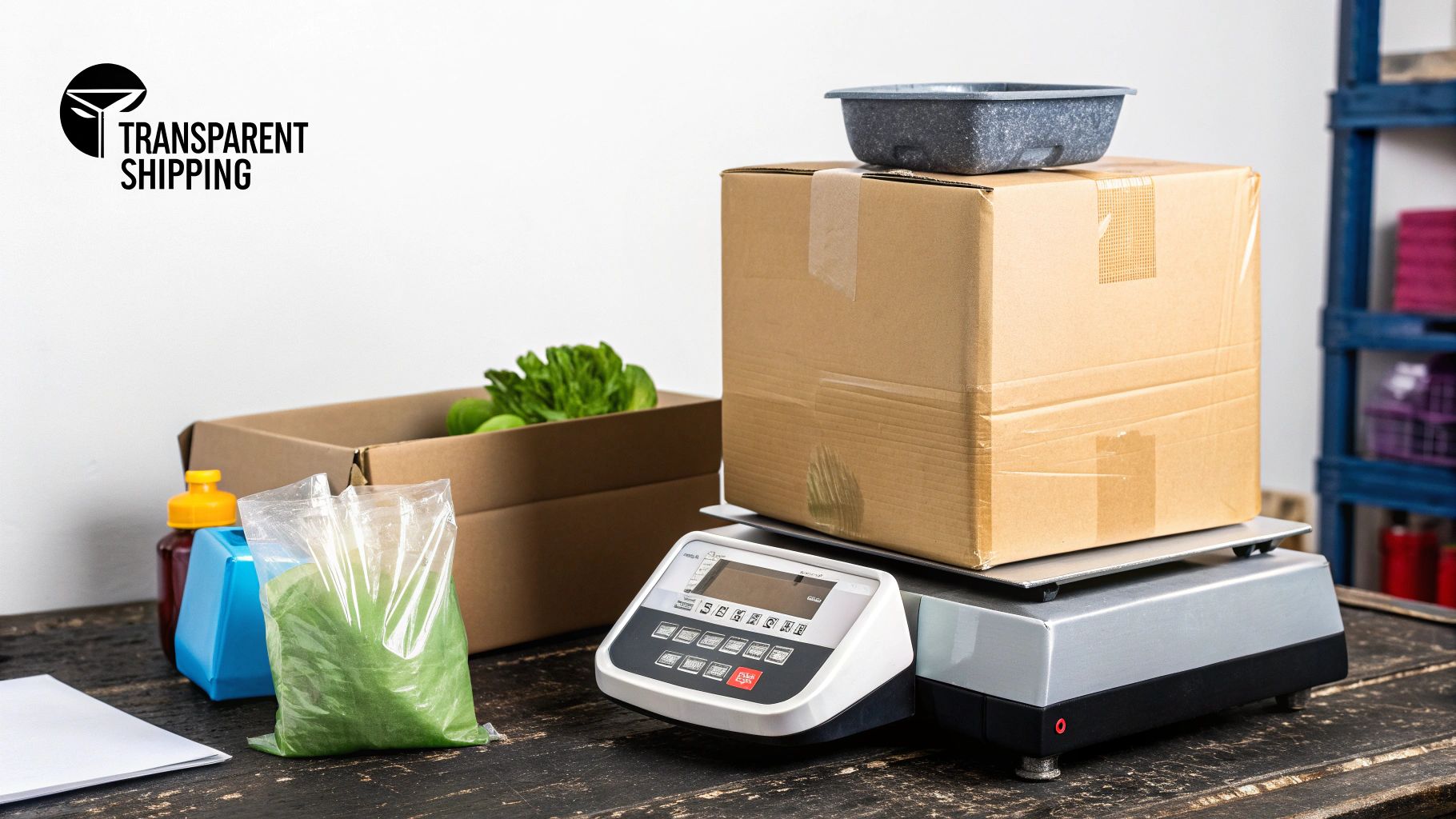That sinking feeling when you check your analytics and see another abandoned cart? We get it. From our experience with over 500 Shopify stores, it's the universal pain point for e-commerce founders. Knowing how to reduce cart abandonment isn't about small tweaks; it’s about fundamentally changing how you communicate with customers who were seconds away from buying.
The truth is, accepting high abandonment rates is a critical mistake that eats directly into your profit margins. But there's good news. In this playbook, you'll learn exactly how to plug the leaks in your checkout, win back customers on the channels they actually use, and turn those lost sales into a predictable revenue stream.
The Sobering Reality of Lost Sales and How to Fix It
Let's be direct: every abandoned cart represents a customer who showed genuine intent. They navigated your store, picked out a product, and were almost yours. The problem usually isn't a lack of interest—it's friction in the buying process.

As an official Meta Business Partner, we've helped hundreds of Shopify stores tackle this head-on. A common mistake we see is brands hemorrhaging revenue from issues that are surprisingly easy to fix.
Why Are Your Customers Really Leaving?
The first step is always to understand the "why." According to Statista, the global average shopping cart abandonment rate hit a staggering 70.19% in 2024. Think about that: for every 10 customers who add items to their cart, seven leave without paying. If you want to dig deeper into the data, VWO's comprehensive cart abandonment statistics breakdown is an excellent resource.
A common mistake we see is brands treating all abandoned carts the same. A customer who leaves because of high shipping fees needs a different follow-up than someone who was just browsing. Your recovery strategy must address the specific reason for abandonment.
From what we’ve seen in the trenches, these are the primary culprits time and time again:
- Unexpected Costs: This is the #1 conversion killer, hands down. High shipping fees, taxes, or handling charges that only appear on the final screen create sticker shock and destroy trust.
- A Complicated Checkout: Forcing users to create an account or asking for a laundry list of information introduces friction that busy customers won't tolerate.
- Lack of Trust Signals: A checkout page without security badges, customer reviews, or a clear return policy makes first-time buyers hesitate to enter their payment details.
- Poor Mobile Experience: With over half of e-commerce traffic coming from mobile, a checkout that isn't optimized for small screens is a surefire way to lose sales.
Your Immediate Cart Abandonment Checklist
Tackling cart abandonment doesn't require a massive, expensive overhaul. The strategy that consistently delivers the best results for our clients is addressing a few foundational issues first.
We've put together this quick-glance table to help you diagnose and fix the most common problems. Think of it as your first-aid kit for abandoned carts.
Fixing these core issues is your first line of defense. Once you plug these leaks, you can focus on winning back the customers who still slip through—and that's where a powerful tool like our WhatsApp cart recovery flows can make all the difference.
Why Your Checkout Is Leaking Money and How to Plug It
Your checkout process should be the smoothest, most reassuring part of the entire customer journey. Instead, for many brands, it’s a minefield of friction. If you really want to know how to reduce cart abandonment, optimizing this final step is non-negotiable.
From our experience with over 500 Shopify stores, the best checkout is one you barely notice—it's so simple and intuitive that the customer glides right through it. This isn't about flashy design; it's about ruthlessly eliminating every reason for a shopper to pause.
Ditch Mandatory Accounts for Good
One of the biggest conversion killers we see is forcing customers to create an account before they can buy. Put yourself in their shoes: they are ready to hand over their money, but you're suddenly shoving a registration form in their face.
The solution is simple: always offer a prominent guest checkout option.
A classic mistake is burying the guest checkout link below the login fields. You must make it the default, most visible choice. Secure the sale first; you can always invite them to create an account on the "Thank You" page after the purchase is complete.
We've seen clients boost their checkout completion rate by double digits with this one change alone. It’s that powerful.
Build Trust with Familiar Payment Options
When a customer pulls out their credit card, they're taking a leap of faith. It's your job to make that leap feel as safe as possible. A checkout page with only one obscure payment method is a major red flag.
You absolutely need to integrate trusted, widely recognized payment gateways.
- Shopify Payments: This should be your baseline. It’s seamless and trusted by millions.
- PayPal: A must-have. Many customers prefer it because they don’t have to re-enter card details.
- Digital Wallets (Apple Pay & Google Pay): These are non-negotiable for mobile conversions, enabling one-tap payments that are both fast and secure.
Here’s a real-world example from a brand we work with of a clean, trustworthy checkout that offers multiple payment methods, making the customer feel secure.

This layout immediately builds confidence by displaying recognizable brands and simplifying the final step.
Show Customers the Finish Line
Anxiety builds when a process feels like it might never end. A multi-page checkout without a clear path forward feels overwhelming.
This is where a progress indicator becomes an incredibly effective psychological tool. A simple bar at the top showing steps like "Shipping > Payment > Review" accomplishes two critical things:
- It manages expectations: The customer knows exactly where they are in the process.
- It builds momentum: Seeing the progress bar move forward encourages them to complete the final steps.
This small UI element provides clarity and guides the user straight to the finish line.
Of course, even with a flawless checkout, some shoppers will still leave. Exploring powerful marketing automation workflow examples, including those for abandoned carts, can help you recover that lost revenue. For inspiration, check out these highly effective abandoned cart email examples to complement your wider strategy.
Winning Back Customers on WhatsApp (It's More Than Email)
For years, email was the standard for cart recovery. But let’s be honest—customer inboxes are a battlefield. If you’re serious about figuring out how to reduce cart abandonment, you need to meet customers where they are actually engaged: WhatsApp.
The data is undeniable. A good email open rate is around 20%. In contrast, WhatsApp messages boast a 98% open rate. With numbers like that, your message is virtually guaranteed to be read, giving you a direct line to someone moments away from buying.
The Power of Conversational Recovery
The real advantage of WhatsApp isn't just the open rate; it's that you can turn a stale notification into a genuine conversation. An email is a monologue; a WhatsApp message starts a dialogue. This is your chance to answer last-minute questions and personally guide a customer across the finish line.
As an official Meta Business Partner, our team at Kanal helps brands build these conversational flows every day. The strategy that consistently delivers the best results for our clients is a straightforward, three-message sequence that actively engages.
Your First WhatsApp Cart Recovery Flow Template
Setting up an effective recovery flow is simpler than you might think. Here’s a blueprint you can put into action today.
Message 1: The Gentle Nudge (Send After 60 Minutes)
- Goal: A friendly reminder while the impulse to buy is still strong. Don't offer a discount yet.
- Template: "Hey [Customer Name]! It looks like you left something behind in your cart. Did you have any questions about the [Product Name]? We’ve saved your items for you here: [Cart Link]"
- Why it Works: It comes across as helpful, not salesy. Asking a question opens the door for a real conversation.
Message 2: The Value-Add (Send After 12-24 Hours)
- Goal: Tackle one of the most common purchase blockers: shipping costs.
- Template: "Hi [Customer Name], still thinking it over? We noticed you left some great items in your cart. To make it easier, we’d like to offer you FREE SHIPPING on your order. Complete your purchase here: [Cart Link]"
- Why it Works: You directly address the #1 reason for cart abandonment without devaluing your product.
The infographic below highlights how flexible payment and shipping options can significantly boost conversions by reducing friction.

This data shows a clear connection between checkout flexibility and completed sales.
Message 3: The Final Offer (Send After 48 Hours)
- Goal: Create urgency and give one last nudge to convert.
- Template: "Hey [Customer Name], this is your last chance to grab your items! Use code COMEBACK10 for 10% OFF your order, but hurry—your cart expires in 3 hours. Get it now: [Cart Link]"
- Why it Works: The combination of a time-sensitive discount creates a powerful fear of missing out (FOMO) that drives immediate action. This is the kind of flow we see generating fantastic ROAS (Return on Ad Spend) for our clients.
Making Checkout Frictionless with Interactive Features
The WhatsApp Business Platform lets you embed interactive elements that make buying almost effortless. For instance, inside Kanal, you can add Quick Reply Buttons directly to your messages.
A common mistake we see brands make is just dropping a link and hoping for the best. Instead, guide their next action. Use buttons like "Complete Purchase" or "Ask a Question" to turn a passive message into an interactive experience.
This approach simplifies the journey and gives you invaluable feedback. To see more advanced tactics, check out our complete guide to building a WhatsApp abandoned cart recovery strategy.
Mastering the Mobile Checkout Experience
If your store isn’t built for mobile-first, you're leaving money on the table. A responsive theme isn't enough. You have to get obsessed with the mobile user's journey.

The data doesn't lie: mobile users abandon carts at a shocking rate of 80.2%, far higher than desktop. This gap comes from mobile-specific frustrations—slow load times, tiny buttons, and clunky forms. To see how critical this is, check out the device-specific abandonment rates at Analyzify.
Audit Your Mobile Journey Like a Customer
The most powerful thing you can do is buy something from your own store on your phone. Feel the experience as your customers do and be ruthless in spotting friction.
From our experience with over 500 Shopify stores, the brands that win on mobile are the ones that obsessively eliminate every obstacle.
- Typing is the Enemy: How much are you making people type with their thumbs? Every field you can remove is a win. Use address auto-complete everywhere.
- The "Fat Finger" Test: Are your buttons and form fields big enough to be tapped easily? If someone has to pinch-and-zoom, your design has failed.
- Load Speed is Everything: Mobile shoppers are not patient. Use a tool like Google's PageSpeed Insights to check your mobile load time. If your checkout pages take longer than 2-3 seconds to load, you are losing sales.
The strategy that consistently delivers the best results for our clients is a ruthless focus on simplification. It’s not about adding features; it’s about taking away everything that isn’t absolutely essential to the purchase.
Redesigning for Thumbs, Not Cursors
Once you’ve found the pain points, fix them. The goal is a checkout that feels natural on a phone.
For mobile, a one-page checkout can be a game-changer. It puts everything on a single screen, cutting down on clicks and reducing anxiety.
Above all, you must prioritize mobile-first payment options:
- Lead with Digital Wallets: Make Apple Pay and Google Pay the most obvious options. They offer one-tap, secure payments—the gold standard for mobile.
- Keep Forms Simple: Only ask for what you absolutely need. Do you really need their phone number right now? If not, cut it.
- Optimize Images: Compress your product thumbnails and trust badges for mobile. Heavy images are a primary cause of slow load times.
Mastering mobile is a critical step to reduce cart abandonment. By building a checkout designed for the small screen, you make it incredibly easy for customers to give you their money. And once you've dialed in the front end, you can use tools like our AI-powered customer lifetime value calculator to better understand the long-term impact of every conversion you save.
Go Deeper with Smart Segmentation and Personalization
You’ve plugged the obvious leaks and have a basic recovery message in place. Now it’s time to get sophisticated. A one-size-fits-all recovery flow will eventually hit a ceiling. To really move the needle, you have to treat different shoppers differently.
From our experience with over 500 Shopify stores, what separates good from great isn't more flows; it's smarter flows. This is where advanced segmentation turns automated messages into personal, helpful nudges.
Break Down Your Recovery Flows for Maximum Impact
The biggest leap in performance we see comes when brands move beyond one generic recovery sequence. The goal is to build distinct flows tailored to specific customer behaviors.
Here are the segments that consistently pay off for our clients:
- By Cart Value: A shopper abandoning a $500 purchase has different hesitations than someone leaving a $50 cart. For high-value carts, you can justify a better discount or even a direct prompt on WhatsApp to chat with a support expert.
- By Customer History: Is this a first-time visitor or a loyal fan? A newcomer might need a first-purchase discount. A returning customer might respond better to an exclusive offer or early access.
- By Specific Products: Did they abandon a low-margin accessory or a high-margin hero product? You can be more generous with discounts on items with more wiggle room. If someone drops a complex product, a WhatsApp message offering to connect them with a specialist can make all the difference.
Tailor Your Offers to Your Industry
Personalization is also about your market. A strategy for fast fashion will likely fall flat for high-end furniture.
Industries like jewelry (abandonment rates up to 81.68%) and home furnishings (78.65%) see shoppers pause more often. These customers are doing heavy research and need more than a discount code. You can see how your store's rate compares to get a better sense of your baseline.
Here's a real-world example from a brand we work with:
A fashion brand discovered a 10% discount paired with a "low stock" alert in their WhatsApp recovery flow was the perfect recipe for urgency.Meanwhile, a home goods client found that offering a discount hurt conversions. Their customers responded better to messages highlighting their free white-glove delivery and flexible return policy. They weren’t worried about price; they were worried about hassle.
Think Beyond a Single Sale
A sophisticated recovery strategy isn’t just about clawing back one transaction. It’s about nurturing the long-term value (LTV) of every customer.
When you personalize your approach, you build a stronger relationship. A customer who feels understood is far more likely to return, dramatically increasing their LTV. Want to see what this looks like for your business? Use our AI-powered customer lifetime value calculator to model how retaining just a few more customers each month can compound over time. This is how you turn a recovery tactic into a strategic growth engine.
Your Action Plan to Stop Losing Sales Today
Alright, you have the full playbook on how to reduce cart abandonment. Now it's time to put these ideas into action. Let's build a practical plan to stop watching revenue walk away.
Start with the fundamentals. The biggest change you can make right now is to get rid of surprise costs. Be upfront about shipping fees from the very beginning. Then, focus on a smooth checkout. Enable guest checkout by default and add one-tap payment options like Shop Pay.
From our experience, the strategies that really move the needle are the ones that meet customers on their terms. This is where a well-crafted WhatsApp recovery sequence becomes your most valuable player.
Your Final Takeaway: Think of reducing cart abandonment as an ongoing process, not a one-time project. It’s a cycle of testing, learning, and refining. Start with the low-hanging fruit—like clarifying your shipping policy—and build momentum from there.
The methods we’ve covered are the exact ones we use at Kanal to help clients turn abandoned carts into a profitable revenue channel. A deep understanding of your customer's journey is crucial. For a closer look, our guide on eCommerce funnel analysis gives you a solid framework for pinpointing where shoppers drop off.
The strategies are here. The tools are ready. The next move is yours.
Ready to turn your abandoned carts into a reliable revenue engine? Install Kanal on your Shopify store today or schedule a demo to see it in action.
Answering Your Top Cart Abandonment Questions
We talk to e-commerce brands every day, and the same questions about tackling abandoned carts pop up time and again. Let's clear up the most common uncertainties.
What’s a Realistic Cart Abandonment Rate to Aim For?
It's easy to get fixated on the global average of 70%. But honestly, that number is too broad to be useful. A "good" rate depends on what you sell.
From our experience with over 500 Shopify stores, a sharp fashion brand can realistically get its rate down to the 55-65% range. If you sell lower-priced items, pushing below 50% is a fantastic goal.
Our advice: Stop chasing a universal benchmark. The real win is consistently lowering your own rate month after month. That's the metric that truly matters.
How Quickly Should I Send a Recovery Message?
Timing is everything. Send a message too fast, and you sound pushy. Wait too long, and the buying impulse is gone.
Our data consistently shows that for WhatsApp, the magic window for the first message is 30 to 60 minutes after abandonment. The customer's interest is still high.
The three-part sequence that works best for our clients is:
- First Message: A reminder within 30-60 minutes.
- Second Message: A follow-up 12-24 hours later.
- Final Message: A last-chance offer after 48 hours.
This escalating cadence is the strategy we see deliver the best results, time and time again.
Will Offering Discounts Destroy My Profit Margins?
This is a valid concern. But you have to see recovery discounts as a strategic investment, not a cost. It costs far less to convert a warm lead than to acquire a new customer through paid ads.
The key is to be smart with your offers. Don't throw a discount at everyone.
- Start with a simple nudge. Your first message can be a friendly reminder with no discount. You’d be surprised how often this works.
- Next, try offering free shipping. This tackles the #1 reason for abandonment without devaluing your products.
- As a final push, use a percentage discount. This is your ace in the hole to close the deal.
By layering your offers and segmenting them—saving bigger discounts for high-value carts—you protect your margins while boosting recovery revenue. It's not about giving away profit; it's about investing it wisely to get the highest return.
Ready to turn those abandoned carts into a reliable revenue engine? Kanal can help.
Install Kanal on your Shopify store or schedule a demo with our team to see how it all works.



